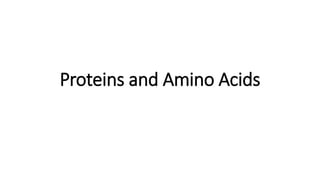
Amino acids and proteins.pptx
- 1. Proteins and Amino Acids
- 2. Introduction • Proteins are the most abundant organic molecules of the living system. • They occur in every part of the cell and constitute about 50% of the cellular dry weight. • Proteins form the fundamental basis of structure and function of life.
- 3. Introduction… • The functions of proteins are grouped as 1. Structural functions: Example: collagen and elastin found in bone matrix, vascular system and other organs and α-keratin present in epidermal tissues 2. Dynamic functions: Example: enzymes, hormones, blood clotting factors, immunoglobulins, membrane receptors, storage proteins • Proteins are polymers of amino acids
- 4. Amino acids • Amino acids are a group of organic compounds containing two functional groups— amino and carboxyl • The amino acids are termed as α-amino acids, if both the carboxyl and amino groups are attached to the same carbon atom • The amino group (—NH2) is basic while the carboxyl group (—COOH) is acidic in nature.
- 5. Amino acids • There are about 300 amino acids occurring in nature but only 20 of them occur In proteins. • The 20 amino acids are different in the R group. • The amino acids (except glycine) possess optical isomerism. • Contain asymmetric carbon atom (attached to four different groups) • The amino acids of the proteins are L-α-amino acids (α-amino group is on the left side configuration).
- 6. Amino acids… • One of the 20 amino acids called proline is not an amino acid. • It is an imino acid as It contains imino group (-NH).
- 7. Amino acids… • At physiological pH (approximately pH=7 .4) the carboxyl group is dissociated forming a negatively charged carboxylate ion (-COO-) and the amino group is protonated, forming positively charged ion (-NH3 +)
- 8. Abbreviations and symbols of amino acids
- 9. Classification of amino acids A. Amino acid classification based on the structure A. Nutritional classification of amino acids A. Amino acid classification based on their metabolic fate
- 10. A. Amino acid classification based on the structure • Amino acids are classified according to the side chain: a. Nonpolar, Aliphatic R Groups b. Aromatic R Groups c. Polar, Uncharged R Groups d. Positively Charged (Basic) R Groups e. Negatively Charged (Acidic) R Groups
- 11. A. Amino acid classification based on the structure
- 12. B. Nutritional classification of amino acids • Based on the nutritional requirements, amino acids are grouped into two classes: 1. Essential or indispensable amino acids: • Cannot be synthesized by the body and need to be supplied through the diet • These are 10 amino acids: Arginine, Valine, Histidine, Isoleucine, Leucine, Lysine, Methionine, Phenylalanine, Threonine, Tryptophan.(A.V. HILL, MP., T. T.) • arginine and histidine are semi-essential amino acids 2. Non-essential or dispensable amino acids: • The body can synthesize and need not be consumed in the diet • These are 10 amino acids: glycine, alanine, serine, cysteine, aspartate, asparagine, glutamate, glutamine, tyrosine and proline
- 13. C. Amino acid classification based on their metabolic fate • From metabolic view point, amino acids (carbon skeleton of amino acids) are divided into three groups 1. Glycogenic amino acids • These amino acids can serve as precursors for the formation of glucose or glycogen. • Example: alanine, aspartate, glycine, methionine etc 2. Ketogenic amino acids • Fat can be synthesized from these amino acids. • Two amino acids leucine and lysine are exclusively ketogenic. 3. Glycogenic and ketogenic amino acids • The four amino acids isoleucine, phenylalanine, tryptophan, tyrosine are precursors for synthesis of glucose as well as fat
- 14. STRUCTURE OF PROTEINS • Proteins are the polymers of L-α-amino acids linked together by peptide bond • The structure of proteins can be divided into 4 levels of organization: 1. Primary structure : • The linear sequence of amino acids forming the backbone of proteins (polypeptides). 2. Secondary structure : • The spatial arrangement of protein by twisting of the polypeptide chain. 3. Tertiary structure : • The three dimensional structure of a functional protein. 4. Quaternary structure : • proteins composed of two or more polypeptide chains (subunits)
- 16. STRUCTURE OF PROTEINS • The term protein is generally used for a polypeptide containing more than 50 amino acids. • Some authors use ‘polypeptide’ even if the number of amino acids is a few hundreds. • They prefer to use protein to an assembly of polypeptide chains with quaternary structure
- 17. PRIMARY STRUCTURE OF PROTEIN • Each protein has a unique sequence of amino acids which is determined by the genes contained in DNA. • The amino acid composition of a protein determines its physical and chemical properties • The amino acids are held together in a protein by covalent peptide bonds or linkages • It is when the amino group of an amino acid combines with the carboxyl group of another amino acid • Conventionally, the peptide chains are written with the free amino end (N-terminal residue) at the left, and the free carboxyl end (C- terminal residue) at the right
- 18. PRIMARY STRUCTURE OF PROTEIN Formation of a peptide bond. Use of symbols in representing a peptide
- 19. SECONDARY STRUCTURE OF PROTEIN • It is the conformation of polypeptide chain by twisting or folding • Two types of secondary structures, α-helix and β-sheet